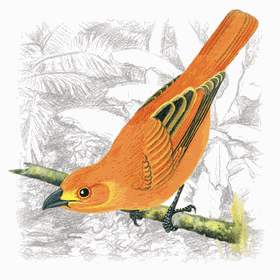 Hepatic Tanager Hepatic Tanager (Piranga flava)
[order] PASSERIFORMES | [family] Thraupidae | [latin] Piranga flava | [UK] Hepatic Tanager | [FR] Piranga orange | [DE] Zinnobertangare | [ES] tangara encinera | [NL] Gele Tangare
Subspecies
Physical charateristicsThe male is red to red-orange. Ear coverts, back, and flanks grayish. Bill dark, blackish on upper mandible, light gray on lower with black tip. The female has forehead, throat, and underparts olive-yellow to orange-yellow. Ear coverts and flanks grayish. Crown, nape, wings, and back grayish olive.
Listen to the sound of Hepatic Tanager [audio:http://www.aviflevoland.nl/sounddb/H/Hepatic Tanager.mp3]
RangeNorth America, Middle America : West USA to Nicaragua
HabitatThey are found in more open woodland and scrub habitats and appear to be benefiting from deforestation in some areas.
ReproductionNest a flat cup of plant fibers, grasses, and twigs. Lined with pine needles and soft materials. Placed in fork near end of horizontal tree branch. Three to five blue green eggs with brown markings are laid in a shallow cup nest built on a low horizontal branch, 5 to 15 meter above the ground. Eggs are incubated by the female for about 13 to 14 days.
Feeding habitsThey feed on a variety of fruit as well as insects of which bees and wasps seem to be favourites. Hepatic Tanager: Feeds mostly on insects in upper foliage of tall trees, where it gleans prey from branches, stems, and leaves. Sometimes catches insects in flight. Also eats fruits.
ConservationThis species has a large range, with an estimated global extent of occurrence of 5,600,000 km2. It has a large global population estimated to be 360,000 individuals (Rich et al. 2003). Global population trends have not been quantified, but the species is not believed to approach the thresholds for the population decline criterion of the IUCN Red List (i.e., declining more than 30% in ten years or three generations). For these reasons, the species is evaluated as Least Concern.

MigrationSedentary throughout range (given the Surinam subspecies)
Distribution map
|
]]>
